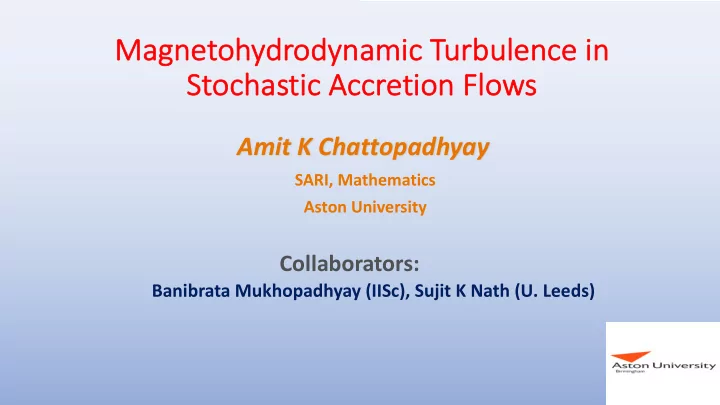

Ma Magnetoh ohydrod odynami mic T Turb rbulence i in St Stoch ochastic A c Accr ccretion on F Flows Amit K Chattopadhyay SARI, Mathematics Aston University Collaborators: Banibrata Mukhopadhyay (IISc), Sujit K Nath (U. Leeds)
The talk was based on the following papers
Accretion-Jet Formation
Accr ccretion flows A A rot otating mass (e. (e.g. disc) ) in a clos osed ed or orbit arou ound a cen entral gravitating bod ody (e. (e.g. black hol ole) e) can em emit radiation when en en ener ergy & angular momen entum are e extract cted ed è in inwar ard d spir piralling alling orbit bit ↑ ↑ jet ↑ ↑ ↑ ↑ T≤10 7 K soft X-rays ↓ or UV ↓ ↓ ←T~10 10 K Hard X-rays : advection ↓ ↓ jet ↓ ↓
Ma Magne neto-Ro Rotational-In Instability y (MRI) RI) Mukhopadhyay-Afshordi-Narayan ApJ 2005 : Fast transient growth in instability due to non-normal modes, arising out of Coriolis force. The energy grows by more than a factor of 100 for a Reynolds number R = 300 and more than a factor of 1000 for R = 1000 è Turbulence. For a Keplerian disk, similar perturbations with vertical structure grow by no more than a factor of 4, explaining why the same simulations did not find turbulence in this system.
Ge General al se set of MHD equatio ions: s: Hot flo lows In a local shearing Ω ~ 1/r q , box Nath & Mukhopadhyay 2015
Co Complex plane (Argand diagram): Strong magnetic field effects Bhatia & Mukhopadhyay 2016
Un Unanswered Questions from MRI Th Theory 1. Is there any pure hydrodynamic instability? NO! (Pringle, Ann. Rev. AA 1981). 2. What to do with non-magnetic instability ? 3. How to incorporate the fact that thermal instability > viscous instability ? 4. Can we accommodate the fact that even ‘cold’ accretion stars are actually very hot - 10 3 C (cold X-ray star) to 10 6 C (hot X-ray star) ? Our Hypothesis: Draw from De Dominicis-Martin ( PRA 19, 419, 1979 ) Chattopadhyay-Bhattacharjee • ( PRE 63, 0116306, 2000 ) models of stochastically forced Navier-Stokes flows in sheared coaxial cylinders (total velocity u = u c + u b ) that directly addresses points 2-4 above and laterally 1. OUR MODEL : stochastically forced Orr-Sommerfeld and Squire equations in • presence of Coriolis force
Fo Forced Orr-Som Sommerfeld Mod odel: Magn gnetic vs St Stoc ochastic: Ch Chattopadhyay-Mu Mukhopadhyay Mo Model } Magnetized Non-normal model } Stochastic Model (magnetic fluctuations à noise) } Noise Strength
Co Correlation F Functions
Te Temporal Correlation vs Time Difference ( Sh g instability ) Shows stron ong g and fast gr growing C u C u 10 6 10 8 10 7 10 5 10 6 10 4 10 5 10 4 1000 1000 100 100 Τ 0.05 0.10 0.50 1.00 5.00 10.00 Τ 0.05 0.10 0.50 1.00 5.00 10.00
Sp Spatial ial Correla latio ion vs Length Sc Scale ale ( Fi spatial instability ) Finite length su suppressi ssion of f sp S u S u 1 � 10 4 10 7 5000 2000 10 5 1000 500 1000 200 r r 10 � 4 10 � 4 0.001 0.01 0.1 0.001 0.01 0.1
k � u 1000 0.1 10 � 5 10 � 9 10 � 13 10 � 17 10 5 k 10 4 10 100 1000
MA MAGNETIZED & & Stocha chastically Force ced d Orr rr-Sommerf rfeld d Mo Mode del: Cha Chattopa padh dhyay-Nath h Mo Mode del Noise Strength
Sp Spatio ioTemporal al Correla latio ion vs Sp Spac ace/Tim ime Dif ifference
Sp Spatio ioTemporal al Cross-Co Correlations vs Space/Time Difference C ζζ B C u ζ B 10 13 10 12 10 12 10 11 10 11 10 10 10 10 τ 2 4 6 8 10 τ 2 4 6 8 10 Velocity-Vorticity cross-correlation Vorticity-magnetic vorticity cross-correlation q=1.5 (solid), 1.7 (dashed), 1.9 (dotted), ~2 (dot-dashed) q=1.5 (solid), 1.7 (dashed), 1.9 (dotted), ~2 (dot-dashed)
Sp Spatio ioTemporal al Cross-Co Correlations vs Space/Time Difference C uB S uB 10 12 10 10 10 11 10 9 10 10 10 8 10 7 10 9 τ r 10 - 2 2 4 6 8 10 0.05 0.10 0.20 0.50 Velocity-Magnetic field TEMPORAL cross-correlation Vorticity-magnetic vorticity SPATIAL cross-correlation q=1.5 (solid), 1.7 (dashed), 1.9 (dotted), ~2 (dot-dashed) q=1.5 (solid), 1.7 (dashed), 1.9 (dotted), ~2 (dot-dashed)
Summary and Conclusions Ø Origin of instability and then plausible turbulence in accretion discs and similar laboratory shear flows is generally a big question. Ø Magnetorotational Instability (MRI) is a good mechanism for magnetic accretion discs, but it is limited to weak field regime and not applicable to laboratory flows. But that does not explain instability in non-magnetic accretion flows. Ø Stochastic Forcing can bridge the magnetic & non-magnetic accretion ends. Ø Cross-correlations lead to time symmetry violation that ‘adds on’ to the Coriolis force which in turn leads to suppression of Alfven waves at finite time scales.
Recommend
More recommend